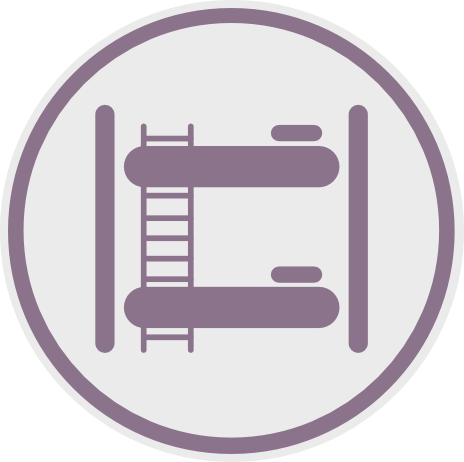Kids Beds Bunk
Bunk beds can add drama and adventure to a child's space. Ms. Keenan adds a shelf for books or a reading light in every sleeping nook to make bunk beds more attractive to children.
Many of our beds for kids bunk are convertible to two complete twin beds which is ideal if you intend to move your children into their own bedrooms in the near future. Choose from finishes such as brushed gray, cream white and rich walnut.
Stairs or ladders
When choosing kids beds bunk, you have the option to choose between ladders or stairs. Ladders are less expensive and simple to put in and offer a straightforward means of climbing into the bed at the top. They are also safer than stairs, as they provide a wider area for children to walk on, and also have an integrated handrail. There are grooves on the steps to prevent slips when climbing up and down the bed.
If you prefer the design and appearance of stairs they could be an elegant addition to your bunk bed. Staircases are also suitable for rooms that are limited in space since they don't extend into the space like ladders do. They are typically constructed of metal or wood and can complement the various styles of bedrooms. Some staircases are even equipped with storage drawers, which are a great way to add more space to the bunk bed.
When deciding between a ladder or stairs take into account the age of your child. While it is recommended that nobody sleep on the top bunk before the age of 6, older children who are comfortable with vertical climbing may be better off with stairs than a ladder. If you intend to use your bunk bed to accommodate guests, such as young children or adults who have limitations in mobility, it's best to choose stairs.
A straight staircase on the opposite side of the bed requires 95" of space each side. If you do not have the space, you can choose an u-shaped staircase that does not require as much space but still allows you to access the top bunk in a safe and securely. Some beds have the option of distancing the stairs when not in use, which reduces their footprint and makes them more suitable for rooms with multiple uses. There are also stairs that connect to the end the bed. This eliminates the requirement for separate handrails and makes it easier to climb up and to the bottom for kids.
Guard Rails
Guard rails let kids climb into and out of their beds on their own and provide them with an experience of freedom and confidence. They must be positioned correctly to ensure there are no gaps or loosening in between the guardrails and the bed's frame. If Bunk Beds Store choose to use guard rails, make sure you follow the instructions of the manufacturer and inspect them frequently for any holes or looseness that could lead to the entrapment.

One of the most important safety tips for bunk beds is to keep them free from electrical devices and other items that could become projectiles when your kids play or sleep. Make sure you place bunks away from windows, which can pose a fall risk if kids get up on the top of the bed.
You might want to put a nightlight on the ladder to illuminate the ladder's climb and descent when your child awakes at night to use the bathroom, or are woken by an erupting storm and have to leave their bedroom.
A safety net can be placed on top of the bunk to keep children from falling out while they sleep or play. This is a great idea especially for older children who are more likely to sleep on the top bunk.
Guardrails should be secured to the bunk bed's structure and must not be removed without the use tools. The guardrail openings that are above the mattress base must not be more than 3.5 inches wide to avoid entrapment or strangulation. To test this, place the wedge block in Figure 1 into each opening on the lower edge of the uppermost guardrail member and above the mattress's underside foundation. Then apply a 33-lbf (147-N) force in a direction that is perpendicular to the plane of the large end of the block and maintain it for a period of 1 minute.
It's a good idea to inform your children to not hang any objects on the ladder or guardrail for example, belts, clothes, or sporting equipment. Instead, you should use a clothes rack to prevent these objects from becoming a strangulation risk for your child. Also, make sure that more than one child should not sleep on the top of the bunk, as this could cause an imbalance that could result in falling.
Mattresses
When choosing a mattress for bunk beds, consider the size and age of your child. A bunk mattress should last at least eight years or until siblings are no longer sharing bedrooms. You'll want to choose one that will grow with your child, but still provide adequate comfort as they age.
There are many options for bunk mattress sizes. They are typically twin or full size. If your children suffer from asthma or allergies, opt for a hypoallergenic mattress with dust mite barriers and a moisture-wicking cover. Kids are likely to experience many accidents and spills, so a mattress that has an antimicrobial layer will help to shield the foam from harmful bacteria and germs.
The feel of your mattress is crucial. Kids generally weigh less than adults, which means they require an item that is firm, but also comfortable. Many hybrid and latex mattress have a firm side and a soft side to meet the needs of both kids and adults.
Memory foam mattresses can work well for kids However, they're not our first choice as they can hold heat and are too difficult on spines of young children. Consider a latex or hybrid mattress that provides solid support and cooling infusions for your child or guests to sleep comfortably.
A mattress with a low profile is typically the best choice for children's bunk beds. These are designed to be thinner than standard mattresses and increase the height of the safety rails for the top bunk. They eliminate "filler" material to provide top quality and durability with a slim design.
Consider an innerspring model or hybrid with upper comfort layers that can be removed and replaced as your child grows. These models will provide an idea of the durability of the mattress as your child grows. You can also include a mattress skirt or bed pad to prevent it from sliding. Some beds even have side rails or a lip built-in to prevent this from happening.
Stores
Bunk beds are a great alternative to save space in shared children's rooms. They can also be a cost-effective alternative to buying two separate full sized single beds. Many bunks also offer the option of a trundle bed that can be tucked away beneath the bunk that is not being used.
To maximize storage and space in a room that has bunk beds, consider creating a kids' bedroom furniture set that includes desks, dressers or bookcases. This will allow you keep all your child's clothing as well as toys and personal belongings in one spot instead of stuffing everything into chests or closets that are overstuffed. The sets of kids bedroom furniture are available at a variety of retailers. They are safe to use and meet federal standards.
Stacked bunks are an imaginative playground as children can transform the space beneath into cozy hidden play areas and hideaway spaces. Designer Elizabeth Georgantas stacked six bunks to create the ultimate kids' space. It can be used to sleep, play or even for superhero cape twirling. The room features a bubble wallcovering by Chasing Paper and a ceiling painted in Benjamin Moore Blue Jean to create the ultimate escape.
If you are unable to build a staircase to your stacked bunk beds A ladder is a good alternative. The ladders are constructed using a single socket Flange, Single Socket, and 90 Degree Side Outlet Fittings. They can be easily adjusted to increase or decrease the distance between the ladder rungs. The ladder rungs are positioned in a straight line with the ground instead of above to facilitate climbing.
Another method to maximize space in a room that has bunk beds is by installing loft beds for kids which can be lowered to just above the floor. This allows you to slide dressers, desks or toy chests directly beneath the beds. This is a great way to maximize space in bedrooms that are small, or in large family homes where beds have to be able to accommodate multiple sleepers.
